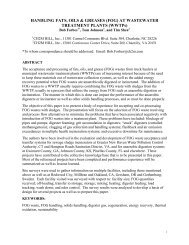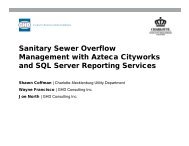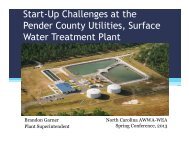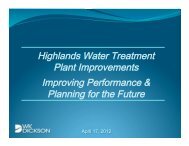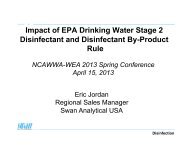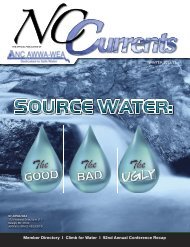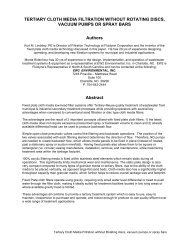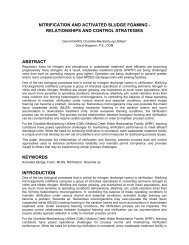GRIT HAPPENS â YOU DON'T KNOW WHAT YOU ARE MISSING
GRIT HAPPENS â YOU DON'T KNOW WHAT YOU ARE MISSING
GRIT HAPPENS â YOU DON'T KNOW WHAT YOU ARE MISSING
- No tags were found...
Create successful ePaper yourself
Turn your PDF publications into a flip-book with our unique Google optimized e-Paper software.
generally provide the plant with adequate protection by removing 80-90% of the grit entering thetreatment plant.Other considerations in this cost analysis would include upstream screening requirements, maintenancerequirements, available space, and anticipated headloss/hydraulic gradient through the process and thelevel of protection to be afforded to downstream equipment and processes. Table 2 outlines importantrecommended guidelines to use when designing or evaluating a grit removal system.TABLE 2. <strong>GRIT</strong> REMOVAL SYSTEM CRITICAL DESIGN FACTORSDesign GuidelineDefine Design Requirements:ü Grit Particle Size Analysisü Settling velocity or Specific Gravityü Required System Removal Efficiencyü Screening RequirementsRequired Downstream Protection:ü Biological Processesü Sludge Processing EquipmentEvaluate Equipment:ü Removal Efficiency/Performanceü Equipment Design/Featuresü Space Requirementsü Headloss Requirementsü Cost: Capital, Installed, Operationalü Maintenance RequirementsEMERGING TRENDHeadworks screening and grit removal is the primary protection for all treatment processes andequipment in a wastewater treatment plant, yet it has been the most neglected part of the plant. Toimprove solids removal screen openings on influent screens have trended progressively smaller over thepast 10-15 years. Years ago screen openings were frequently 1’ and larger. Today, screens arecommonly supplied with ¼” openings. It is logical that improving grit removal processes to effectivelyremove incoming grit is becoming a higher priority in plant designs.Biological processes have evolved to become more efficient and produce a cleaner effluent inprogressively smaller areas. As plants move toward higher performing processes, effective grit removalbecomes more important. The growing acceptance of Membrane Bio-Reactor (MBR) technology bringsthe need for advanced grit management systems into consideration. MBR technology requires extensivescreening pretreatment which protects the membrane and often allows elimination of primary clarification.Without the protection of primary clarification, advanced grit removal should also be part of effective MBRpretreatment system design (Andoh 2009). Grit entering a MBR plant can cause abrasive wear anddamage the membranes, which is often the most expensive equipment in the plant.Fine Bubble aeration is not a particularly advanced treatment process yet when a plant upgrades fromcoarse bubble aeration to fine bubble aeration, and in the process eliminates their primary clarifier, theimpact of grit deposition increases for two reasons. First, the velocity in the aeration basin is reduced asis the deposit limit, making it the first likely location in the process train for grit to accumulate. Secondly,the deposited grit creates new maintenance challenges as diffusers cover the full floor of the basin whichrestricts the ability to clean them and makes the cleaning process more operator intensive and expensive.Diffusers covered with grit are less effective and additional horsepower may be required to achievedesired results.Today many plants are requiring increased effectiveness of their grit removal systems and their designengineers are taking a closer look at the size and settling velocity distributions of grit entering theseplants. Newer editions of design manuals are recommending targeting particles smaller than 212 µm ingrit system design. In 2009, WEF MOP #8 issued a new chapter on Grit Removal stating that in 2008, aGrit Happens – You Don’t Know What You Are Missing




